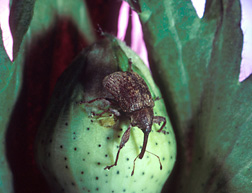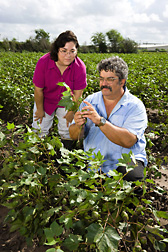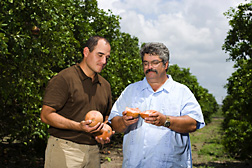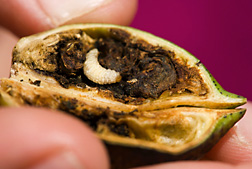What BollWeevils Really Eat, Especially in Subtropical Climes
|
|
For years, the feeding habits and nutritional requirements of the boll weevil (Anthonomus grandis grandis) have been poorly understood, particularly in the subtropical and tropical region that extends from South Texas to Argentina. This may have led to some problems in moving forward with eradication of the boll weevils keen to feed on and lay eggs in cotton buds in such areas.
The boll weevil is a small beetle, measuring only about two-tenths of an inch long, commonly known to feed and lay eggs in cotton buds and bolls. First reports of its presence in the United States occurred in the Lower Rio Grande Valley of Texas in 1892, and it is estimated to have caused about $84 billion in losses since then.
The Boll Weevil Eradication Program—initiated in 1978 by USDA’s Animal and Plant Health Inspection Service with ARS research support and run by eradication foundations—has enabled cotton farmers to reduce their use of pesticides by between 40 and 100 percent in temperate climates where cold winters occur. It has also helped them increase their cotton yields by at least 10 percent since the program’s inception.
|
|
For almost a decade now, scientific work has been done on boll weevil ecology to solve the mysteries of boll weevil behavior in subtropical environments. At the helm of new, breakthrough research is Allan Showler, an entomologist in ARS’s Integrated Farming and Natural Resources Research Unit at Weslaco, Texas.
“Over the 116 years since the boll weevil’s arrival in the United States was first noted, a number of misconceptions, myths, and dogmas have arisen regarding fundamental aspects of boll weevil ecology in the subtropics,” says Showler. “These include its food sources, overwintering, and diapause—an insect version of hibernation.”
For example, “Boll weevils were thought to feed on pollen only, but my work reveals otherwise,” he says.
Nectars Could Be Where It’s At
Even though dissections of boll weevil digestive tracts sometimes yield different kinds of pollen, Showler believes that conclusions about pollen being an important alternative food resource might have been premature. He thinks that boll weevils’ consumption of pollen from host plants other than cotton might actually occur as they’re feeding on nectar. He says that the nutritional properties of such pollens and their effect on boll weevil longevity have not been demonstrated and that boll weevil populations in treelines—where they are assumed to overwinter and perhaps feed on native pollen—substantially decline through the mild winter season of the Lower Rio Grande Valley.
Since nectars and fruit juices cannot readily be observed by microscopic examination—as pollen grains can—these liquids have not, until Showler’s discoveries about boll weevil feeding on fruit endocarps (flesh), been regarded as boll weevil food sources. But it may be no coincidence that boll weevils were first found in the United States at the same time—the early 1890s—as a boom occurred in the citrus industry in the Lower Rio Grande Valley, even though cotton has been grown there since the 1860s.
|
|
Sleepless in the Subtropics
Another misconception about boll weevils is that they always enter diapause, regardless of where they are.
“While diapause might be an overwintering mechanism in the colder winters of temperate areas, it has never been recorded in boll weevils in the subtropics,” says Showler. He has observed that, there, boll weevils remain active and able to reproduce year-round, provided that adequate host plants are available.
“My work clearly shows active boll weevil populations during winter in citrus orchards,” he says. “And other researchers have reported sizable breeding populations on volunteer cotton in mid-winter.”
Showler found that, during winter months, boll weevils generally remain active in the Lower Rio Grande area, surviving by feeding on the flesh of orange, grapefruit, and prickly pear cactus fruit—all common to the subtropics—and possibly on other as-yet unknown food resources. Orange and grapefruit flesh can sustain adult boll weevils for as long as 8 months, which is more than long enough to see them through the cotton-free winter period.
|
|
Findings from this ecological research may open new doors for scientists seeking ways to deal with the boll weevil based on its biology and ecology, rather than on persistent misconceptions. Most of the proposed new tactics recommended by Showler and collaborators do not rely on insecticide use, and one that does ensures that the insecticides would be applied when they will actually strike the target.
Showler’s collective findings—synthesized and published in the winter 2007 edition of American Entomologist—detail the effects of food sources on subtropical weevil population dynamics, both during the cotton-growing season and in winter when cotton is not available. Some of the food sources he identified have been heretofore unknown, and all this new data has paved the way for proposing new survey and control tactics that can augment tactics already in place for boll weevil suppression and eradication programs.—By Alfredo Flores, Agricultural Research Service Information Staff.
This research is part of Crop Protection and Quarantine, an ARS national program (#304) described on the World Wide Web at www.nps.ars.usda.gov.
Allan T. Showler is in the USDA-ARS Integrated Farming and Natural Resources Research Unit, 2413 E. Hwy. 83, Weslaco, TX 78596; phone (956) 969-4882, fax (956) 969-5024.
"What Boll Weevils Really Eat, Especially in Subtropical Climes" was published in the November/December 2008 issue of Agricultural Research magazine.










